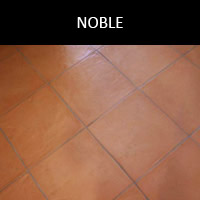
|
The
"Classic" is the terracotta tiles that we used to see in old buildings, houses, towns, churches etc. .... in spite of the centuries always has the same appearance as produced by hand. The surface is slightly rough, the colours are slightly faded, of course every piece is different.
It is suitable for exterior, floors, attic, walls. It is easy to clean, inside should be treated with wax, making it waterproof and smooth to the touch, you can get a shiny or matte appearance using different waxes. The classic terracotta tiles can be sanded to enhance the lived and worn appearance.
|

|
The "Noble Finish" is achieved in the shaping phase, through a special process by hand which makes the surface of the terracotta extremely smooth even if it is not sanded. The edges of the terracotta tiles may be more or less irregular. For this type of finish it a thorough cleaning with acid is recommended after laying, in order to achieve uniform staining of the floor. To obtain a special colour clays pieces of different colour can be mixed during the laying stage.
|

|
The "Cotto Rugantino" has been designed to meet the needs of customers who want a a polished floor or at least that it looks old and worn. It has an extremely smooth surface like a polished product while maintaining the hand-made look, it has imperfections and larger or smaller holes as a floor that is worn over time. This type of finish is well suited to aged treatments with dark colour waxes or oils to reproduce the effect of an old floor. With red oil and shiny wax little differs from a terracotta floor that is centuries old and dirty.
|

|
This type of finish has been given the name "Vellutato Carteggiato" (Velvet Sanded) because it gives the feeling of softness to the touch as to the eye, has a soft colour and shading and a smooth surface. It is achieved with clays specifically worked for this type of product, sanded by hand when it is not yet baked, and it is available in all formats.
|

|
The name of this terracotta already says a lot, "Vecchia Toscana" (Old Tuscany) is a finish Cotto Ceipo with a sanded surface, but with more or less smaller cavity that testify its essence of ancient material. Extremely smooth surface and worn, but imperfect, brings out the nature, the heart of the old terracotta soft paste.
|

|
The Rectangular "Pianelle" are used not only for the floor, but also between the wooden beams in the ceiling, left natural or sandblasted. To prevent the occurrence of efflorescence
(see what these are) the mortar screed should never be placed directly in contact with the brick. The "Tavelle for Attic" must not be exposed to water once laid. Ceipo Ceramics produces a particular kind of flat tile especially designed to have minimum percentage of efflorescent salts, laid in a workmanlike will not give the problem of saltpetre that is extremely difficult to eliminate from a roof.
|